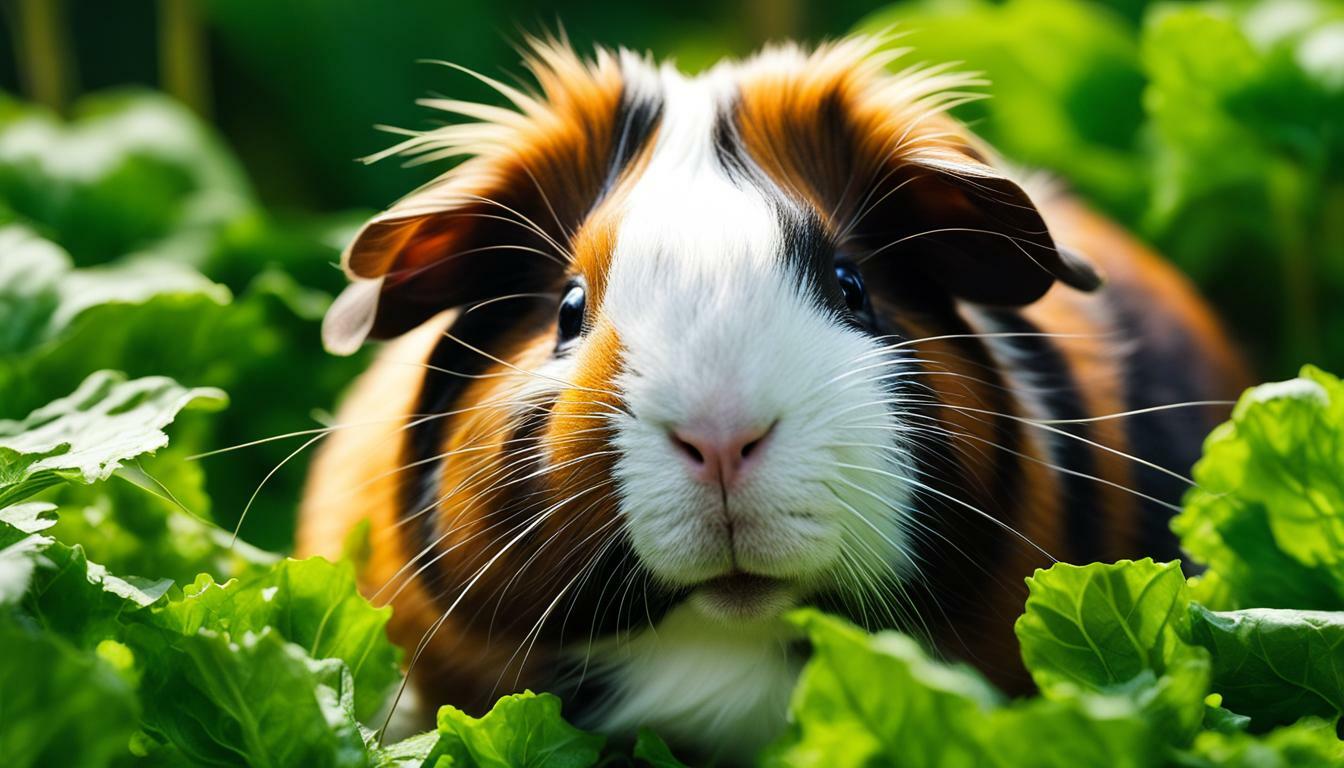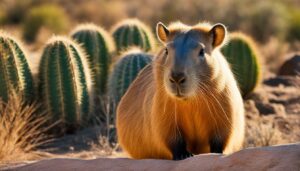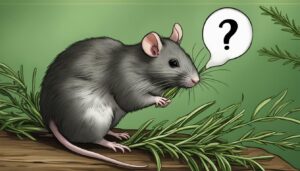Guinea pigs require a balanced diet to thrive, but can they safely consume beet greens? In this article, we will explore the nutritional content of beet greens, the potential risks associated with feeding them to guinea pigs, and best practices for incorporating them into their diet.
Understanding what guinea pigs can and cannot eat is crucial for their overall health and well-being.
Key Takeaways:
- Beet greens can be fed to guinea pigs, but only in moderation.
- High levels of oxalates in beet greens pose a potential risk to guinea pig health.
- Feeding beet greens once a month is recommended to avoid kidney and bladder stones.
- Guinea pigs are strict raw herbivores, so cooked beet greens should be avoided.
- Hay should be the main component of a guinea pig’s diet, followed by vegetables, fruits, and pellets.
Understanding the Guinea Pig’s Nutritional Needs
Before exploring whether guinea pigs can eat beet greens, it is crucial to understand their nutritional needs.
Guinea pigs require a diet that is rich in fiber, vitamins, and minerals to maintain their overall health and well-being.
While guinea pigs are herbivores, not all vegetables are safe for them to consume.
Hay should be the main component of a guinea pig’s diet. It provides essential fiber that aids in digestion and helps maintain dental health.
Additionally, hay keeps their constantly growing teeth worn down to a healthy length. High-quality timothy hay or orchard grass should be available to your guinea pigs at all times.
In addition to hay, guinea pigs should be offered a variety of fresh vegetables. These vegetables should be low in sugar and high in nutrients.
Safe greens for guinea pigs include romaine lettuce, spinach, kale, and cilantro. These vegetables provide important vitamins and minerals that contribute to a balanced diet.
| Safe Vegetables for Guinea Pigs | Unsafe Vegetables for Guinea Pigs |
|---|---|
| Romaine lettuce | Iceberg lettuce |
| Spinach | Rhubarb |
| Kale | Potato leaves and stems |
| Cilantro | Onion |
| Garlic |
It is important to introduce new vegetables gradually to avoid digestive upset. Start with small amounts and observe how your guinea pigs react. If there are no adverse reactions, you can gradually increase the portion size.
Exploring Beet Greens and Their Nutritional Content
Beet greens offer a range of essential nutrients for guinea pigs, including vitamins and minerals necessary for their well-being.
These leafy greens are packed with calcium, which is important for healthy bone development and overall growth.
Guinea pigs also benefit from the high vitamin C content found in beet greens, as this vitamin is vital for collagen synthesis and immune system support.
Aside from calcium and vitamin C, beet greens are a good source of antioxidants and vitamin A, which are essential for maintaining healthy skin, fur, and eye health.
They also contain vitamin K, which is crucial for blood clotting and proper bone metabolism. With these beneficial nutrients, adding beet greens to your guinea pig’s diet can help contribute to their overall nutrition.
However, it is important to note that beet greens should only be fed to guinea pigs in moderation. While they offer nutritional benefits, beet greens also contain high levels of oxalates, which can be harmful to guinea pigs if consumed in excess.
Oxalates can contribute to the formation of kidney and bladder stones, leading to serious health issues.
To ensure the well-being of your guinea pig, it is recommended to feed beet greens no more than once a month.
Table: Nutritional Content of Beet Greens
| Nutrient | Amount per 100g |
|---|---|
| Calcium | 117mg |
| Vitamin C | 30mg |
| Vitamin A | 2200IU |
| Antioxidants | Various |
| Vitamin K | 500mcg |
When feeding beet greens to your guinea pig, it is important to remember that they are strict raw herbivores.
Cooked beet greens should be avoided, as they can lead to digestive issues. Guinea pigs have sensitive digestive systems and thrive on a diet primarily composed of hay.
Hay should be the main component of their diet, followed by a variety of fresh vegetables, limited fruits, and pellets that are specifically formulated for guinea pigs.
In addition to beet greens, there are other foods that are high in oxalates, such as spinach and parsley, which should also be fed to guinea pigs in moderation.
Healthily incorporating a variety of vegetables into their diet ensures that guinea pigs receive a balanced and nutritious meal while minimizing the risk of oxalate-related health issues.
By following these guidelines and providing a diverse diet, you can keep your guinea pig healthy and thriving.
Potential Risks of Feeding Beet Greens to Guinea Pigs
While beet greens can be a valuable addition to a guinea pig’s diet, it is essential to be aware of the potential risks they pose.
Beet greens contain high levels of oxalates, which are compounds that can promote the formation of kidney and bladder stones in guinea pigs.
If consumed in excess, these oxalates can lead to serious health issues for your furry friend.
It is recommended to feed beet greens to guinea pigs only once a month at most, and in small quantities. Moderation is key to prevent the accumulation of oxalates in their system.
Along with the potential risk of stones, excessive intake of oxalates can also interfere with the absorption of calcium, which is crucial for guinea pigs’ bone health and development.
To ensure the well-being of your guinea pig, it is important to provide a varied diet that includes a balance of different vegetables and greens.
While beet greens offer valuable nutrients such as calcium, vitamin C, vitamin A, antioxidants, and vitamin K, it is crucial to supplement their diet with other safe greens and vegetables that have lower oxalate levels.
This way, you can minimize the risk of any adverse effects on their health.
| Oxalate Content in Common Greens | Oxalate Level |
|---|---|
| Beet Greens (cooked) | 1400 mg/100g |
| Spinach (cooked) | 750-970 mg/100g |
| Kale | 20-80 mg/100g |
| Cilantro | 6 mg/100g |
By including a variety of safe greens and vegetables in your guinea pig’s diet, you can provide them with a well-rounded nutritional intake while minimizing the risk of excessive oxalate consumption.
It is always a good idea to consult with a veterinarian to ensure your guinea pig’s diet meets their specific nutritional needs and to address any concerns or questions you may have.
Feeding Beet Greens to Guinea Pigs: Best Practices
To ensure the well-being of your guinea pig, it is crucial to follow best practices when feeding them beet greens.
While beet greens can be included in their diet, it is important to feed them in moderation due to their high oxalate content.
Consuming too many oxalates can lead to kidney and bladder stones, which can be harmful to your pet.
When offering beet greens to your guinea pig, it is recommended to do so only once a month at most.
This allows them to enjoy the nutritional benefits without overexposing them to oxalates. Beet greens are rich in vitamins and minerals including calcium, vitamin C, vitamin A, antioxidants, and vitamin K, making them a healthy addition to their diet.
It is important to note that cooked beet greens should never be given to guinea pigs. These small animals are strict raw herbivores and cooked food can disrupt their delicate digestive systems.
Stick to offering fresh, raw beet greens to ensure their optimal health and digestion.
In addition to beet greens, it is essential to provide your guinea pig with a well-balanced diet. Hay should be the main component of their diet, as it aids in digestion, promotes dental health, and provides essential fiber.
Alongside hay, include a variety of vegetables, fruits, and quality pellets to ensure they receive the necessary nutrients for their overall well-being.
Remember, while beet greens can be a healthy addition to your guinea pig’s diet, it is crucial to feed them in moderation and follow best practices.
By doing so, you can ensure that your furry friend stays happy and healthy for years to come.
The Importance of Hay in a Guinea Pig’s Diet
Hay plays a vital role in the overall health and well-being of guinea pigs, making it a crucial part of their daily diet.
Guinea pigs are herbivores, and their digestive systems are designed to process high-fiber foods. Hay provides the necessary fiber to promote proper digestion and prevent gastrointestinal issues such as bloating and constipation.
In addition to its fiber content, hay also helps maintain dental health in guinea pigs. Guinea pigs’ teeth continuously grow throughout their lives, and chewing on hay helps wear down their teeth naturally.
A lack of proper dental wear can lead to dental problems, including overgrown teeth and painful dental abscesses.
When choosing hay for your guinea pig, opt for high-quality varieties such as Timothy hay or Orchard grass.
These types of hay are low in calcium and protein, which are essential for guinea pigs’ overall health. Avoid hay that is dusty or has mold, as these can pose a risk to your guinea pig’s respiratory system.
| Benefits of Hay in a Guinea Pig’s Diet |
|---|
| Provides essential fiber for proper digestion |
| Aids in maintaining dental health |
| Helps prevent gastrointestinal issues |
| Promotes natural wear of guinea pigs’ teeth |
| Choose high-quality varieties such as Timothy hay or Orchard grass |
| Avoid dusty or moldy hay |
Other Essential Components of a Guinea Pig’s Diet
In addition to hay, a well-balanced diet for guinea pigs should include a variety of vegetables, fruits, and pellets.
Vegetables provide important vitamins and minerals, while fruits should be given sparingly due to their high sugar content.
Pellets can be offered as a supplement to ensure your guinea pig is receiving all the necessary nutrients.
- Vegetables: Offer a mix of leafy greens such as romaine lettuce, spinach, and kale, along with other vegetables like bell peppers, carrots, and cucumbers. Introduce new vegetables gradually to avoid digestive upset and monitor your guinea pig’s reaction to each type.
. - Fruits: Feed small amounts of fruits such as apples, strawberries, and blueberries as an occasional treat. Remember to remove any seeds or pits before serving.
. - Pellets: Choose high-quality guinea pig pellets that are specifically formulated for their nutritional needs. Ensure that the pellets are fresh and stored in a cool, dry place.
By providing a well-balanced diet that includes hay, vegetables, fruits, and pellets, you can ensure that your guinea pig receives all the necessary nutrients for optimal health.
Remember to consult with a veterinarian for specific dietary recommendations based on your guinea pig’s age, weight, and overall health condition.
Other Essential Components of a Guinea Pig’s Diet
In addition to hay, guinea pigs require a variety of other foods to meet their nutritional needs. These foods include vegetables, fruits, and pellets.
It’s important to provide a balanced diet to ensure your guinea pig stays healthy and happy.
Vegetables should make up about 10-15% of your guinea pig’s daily diet. Some safe vegetables for guinea pigs include leafy greens like romaine lettuce, spinach, and kale.
Bell peppers, carrots, and cucumbers are also great options. Remember to introduce new vegetables slowly and in small quantities to prevent digestive upset.
| Safe Vegetables for Guinea Pigs | Unsafe Vegetables for Guinea Pigs |
|---|---|
| Romaine lettuce | Onions |
| Spinach | Garlic |
| Kale | Leeks |
| Bell peppers | Chives |
| Carrots | Shallots |
| Cucumbers | Scallions |
Fruits can be given as treats in small amounts due to their high sugar content. Some safe fruits for guinea pigs include apples, berries, and melons.
Be sure to remove any seeds or pits before giving them to your guinea pig.
Pellets should make up a small portion of your guinea pig’s diet. Look for high-quality pellets that are specifically formulated for guinea pigs.
Avoid pellets that contain added sugars, seeds, or nuts, as they can be harmful to your guinea pig’s health.
By providing a varied diet that includes hay, vegetables, fruits, and pellets, you can ensure that your guinea pig receives all the essential nutrients they need to thrive.
Remember to always introduce new foods gradually and consult with a veterinarian if you have any concerns about your guinea pig’s diet.
Limiting Oxalate-Rich Foods in a Guinea Pig’s Diet
To promote the overall health of your guinea pig, it is crucial to limit the consumption of oxalate-rich foods.
While beet greens are safe to feed in moderation, they contain high levels of oxalates that can potentially lead to kidney and bladder stones if given too frequently.
Therefore, it is recommended to feed beet greens to your guinea pig no more than once a month.
Although beet greens offer nutritional benefits such as calcium, vitamin C, vitamin A, antioxidants, and vitamin K, it’s important to remember that a guinea pig’s diet should consist mainly of hay.
Hay provides crucial fiber for their digestive system and helps maintain healthy teeth. Alongside hay, a variety of vegetables, fruits, and pellets can be included in their diet to ensure a well-rounded nutritional intake.
When selecting other foods for your guinea pig, it’s important to be mindful of their oxalate content. Similar to beet greens, there are several foods that are also high in oxalates.
These include spinach, parsley, kale, and rhubarb. While these foods can be offered occasionally, it’s best to feed them in moderation to mitigate the risk of oxalate-related health issues.
| Foods High in Oxalates | Frequency of Feeding |
|---|---|
| Beet greens | No more than once a month |
| Spinach | Occasionally |
| Parsley | Occasionally |
| Kale | Occasionally |
| Rhubarb | Occasionally |
By limiting the consumption of oxalate-rich foods and providing a balanced diet, you can help ensure the well-being and longevity of your guinea pig.
Remember, moderation is key when it comes to feeding these foods. Consult with a veterinarian for specific dietary recommendations tailored to your guinea pig’s needs.
Cooked Beet Greens and Guinea Pig Digestion
Guinea pigs have specific dietary requirements, and feeding them cooked beet greens can lead to digestive problems.
These adorable and curious little creatures are strict raw herbivores, meaning their digestive system is designed to process and extract nutrients from raw foods.
Cooked foods, including cooked beet greens, can be difficult for guinea pigs to digest and may result in digestive issues such as diarrhea, bloating, and discomfort.
When preparing meals for your guinea pig, it’s important to keep their natural diet in mind. Opt for fresh, raw vegetables and greens that are safe for guinea pigs to eat.
While cooked beet greens may seem like a convenient option, they can potentially disrupt their digestive system and overall well-being.
To ensure a healthy and balanced diet for your guinea pig, focus on providing them with a variety of fresh vegetables, high-quality hay, and a small amount of pellets.
The majority of their diet should consist of hay, which is essential for their dental health, digestion, and overall well-being.
You can complement their hay with a daily assortment of vegetables, offering them a range of nutrients and flavors to enjoy.
| Foods to Feed Your Guinea Pig | Foods to Feed in Moderation |
|---|---|
|
|
When introducing new foods into your guinea pig’s diet, it’s important to do so gradually, monitoring their response and ensuring they do not experience any adverse reactions.
If you notice digestive issues or any other concerns, it’s best to consult with a veterinarian who specializes in small animals.
Remember, while cooked beet greens may be a tempting treat for your guinea pig, it’s best to stick to their natural diet of fresh, raw vegetables.
By providing them with the right foods and maintaining a careful balance, you can help ensure their digestive health and overall well-being.
Conclusion
Safeguard your guinea pig’s health by providing a balanced diet that includes a variety of safe vegetables, while limiting the consumption of beet greens and other foods with high oxalate content.
While guinea pigs can eat beet greens, it’s important to feed them in moderation due to their high oxalate levels.
Too many oxalates can lead to kidney and bladder stones in guinea pigs, so it’s best to offer beet greens no more than once a month.
Beet greens do have nutritional benefits for guinea pigs. They are a good source of vitamins and minerals such as calcium, vitamin C, vitamin A, antioxidants, and vitamin K.
However, the potential risks associated with excessive oxalate consumption outweigh the benefits, so it’s crucial to limit their intake.
In addition to beet greens, it’s essential to focus on a guinea pig’s overall diet. Hay should be the main component as it promotes digestion, dental health, and overall well-being.
Vegetables, fruits, and pellets should also be included in their diet, but the emphasis should always be on hay.
Lastly, remember that guinea pigs are strict raw herbivores. Cooked beet greens or any cooked foods should be avoided as they can cause digestive issues.
It is best to stick to a natural, raw diet for your furry friends. By providing a well-rounded and balanced diet, you can ensure the long-term health and happiness of your guinea pig.
FAQ
Can guinea pigs have beet greens?
Yes, guinea pigs can eat beet greens, but they should only be fed in moderation.
Why should beet greens be fed to guinea pigs in moderation?
Beet greens contain high levels of oxalates, which can cause kidney and bladder stones in guinea pigs if consumed too frequently.
How often should I feed beet greens to my guinea pigs?
It is recommended to only feed beet greens to guinea pigs once a month at most.
What nutrients do beet greens provide to guinea pigs?
Beet greens are a good source of vitamins and minerals such as calcium, vitamin C, vitamin A, antioxidants, and vitamin K.
Can I feed cooked beet greens to my guinea pigs?
No, guinea pigs are strict raw herbivores and cooked food can cause digestive issues. Cooked beet greens should not be fed to guinea pigs.
What should be the main component of my guinea pig’s diet?
Hay should be the main component of your guinea pig’s diet.
What other foods should I feed my guinea pigs?
In addition to hay, guinea pigs can also eat vegetables, fruits, and pellets. These should be fed in moderation.
Are there other foods similar to beet greens that should be fed in moderation?
Yes, other foods that are high in oxalates, similar to beet greens, should also be fed in moderation.




